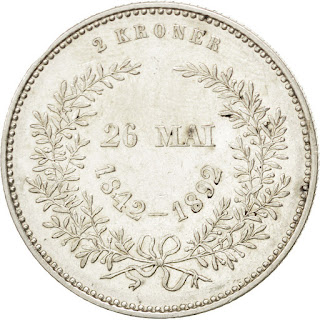Denmark 2 Kroner Silver Coin 1892 Golden Wedding of King Christian IX and Queen Louise
Commemorative issue: Golden Wedding of King Christian IX and Queen Louise
Obverse: Portrait of King Christian IX and Queen Louise, text Kong Christian IX og Dronning Louise, date and initials CS below.
Lettering: KONG CHRISTIAN IX DRONNING LOUISE 1892 CS.
Engraver: CS.
Reverse: Denomination at top, date 26. MAI 1842-1892 with leaves arond.
Lettering: 2 KRONER 26 MAI 1842-1892.
Value: 2 Kroner.
Metal: Silver (.800).
Weight: 15 g.
Diameter: 31 mm.
King Christian IX of Denmark
Christian IX (8 April 1818 – 29 January 1906) was King of Denmark from 1863 to 1906. From 1863 to 1864, he was concurrently Duke of Schleswig, Holstein and Lauenburg.
Growing up as a prince of Schleswig-Holstein-Sonderburg-Glücksburg, a junior branch of the House of Oldenburg which had ruled Denmark since 1448, Christian was originally not in the immediate line of succession to the Danish throne. However, in 1852, Christian was chosen as heir to the Danish monarchy in light of the expected extinction of the senior line of the House of Oldenburg. Upon the death of King Frederick VII of Denmark in 1863, Christian acceded to the throne as the first Danish monarch of the House of Glücksburg.
The beginning of his reign was marked by the Danish defeat in the Second Schleswig War and the subsequent loss of the duchies of Schleswig, Holstein and Lauenburg which made the king immensely unpopular. The following years of his reign were dominated by political disputes as Denmark had only become a constitutional monarchy in 1849 and the balance of power between the sovereign and parliament was still in dispute. In spite of his initial unpopularity and the many years of political strife, where the king was in conflict with large parts of the population, his popularity recovered towards the end of his reign, and he became a national icon due to the length of his reign and the high standards of personal morality with which he was identified.
Christian married his second cousin, Princess Louise of Hesse-Kassel, in 1842. Their six children married into other royal families across Europe, earning him the sobriquet "the father-in-law of Europe". Most current European monarchs are descended from him, including Queen Margrethe II of Denmark, Queen Elizabeth II of the United Kingdom, King Philippe of Belgium, King Harald V of Norway, King Felipe VI of Spain, and Grand Duke Henri of Luxembourg. The British consort Prince Philip, Duke of Edinburgh is also an agnatic descendant of Christian IX, as are Michael I of Romania and Constantine II of Greece, whose thrones have been abolished. Also, the queens consort Anne of Romania, Anne-Marie of Greece, and Queen Sofia of Spain are among his descendants.
Louise of Hesse-Kassel
Louise of Hesse (German: Luise Wilhelmine Friederike Caroline Auguste Julie von Hessen-Kassel, Danish: Louise Wilhelmine Frederikke Caroline Auguste Julie) (7 September 1817 – 29 September 1898) was Queen of Denmark as the wife of King Christian IX of Denmark.
Marriage
Louise was married at the Amalienborg Palace in Copenhagen on 26 May 1842 to her second cousin Prince Christian of Schleswig-Holstein-Sonderburg-Glucksburg. He was soon selected as hereditary prince of Denmark and later ascended the throne of Denmark as King Christian IX. The marriage greatly strengthed Christian's efforts to secure the Danish throne, since it joined two competing claimants whose children would have an enhanced connection to the ancient bloodlines of the Danish monarchy. Louise and Christian lived a quiet family life. Louise's mother and siblings renounced their rights to the Danish throne to her. Louise herself in turn renounced her rights to the throne to her spouse Christian. In 1852, this succession order was confirmed by the Nordic countries and foreign powers in London.
In 1847, Prince Christian was, with the approval of Europe's Great Powers, chosen as successor to the Danish throne by Christian VIII (who did not expect his only surviving son, the future Frederick VII, to father dynastic sons). This choice of heir was made more dynastically palatable by the fact that, thanks to the mass renunciations of the Hesses, Christian's wife Louise became the heiress eventual to the crown, meaning that the couple's children would be heirs to the throne both by right of international treaty and by compliance with the Lex Regia. This resolved the succession to the Danish crown, but not Denmark's claim on the twin duchies of Schleswig and Holstein. German Holstein's historic law of succession was Salic and could not so easily be reconciled with Christian's claim so long as the Augustenborgs survived and Prussia offered itself as the international champion of German nationalism. The result of this conflict was the Second War of Schleswig.
On 3 July 1853, King Frederick VII confirmed this succession. By that act, Louise and Christian became Crown Princess and Crown Prince of Denmark. Louise had a tense relationship with King Frederick VII, who contradicted the succession of her spouse, and whose marriage to the non-royal Louise Rasmussen she did not approve of. Therefore, the King and the Crown Prince couple did not see each other very often.

